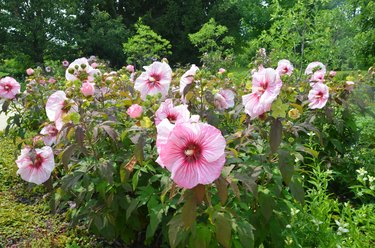
Plants like hardy hibiscus (Hibiscus moscheutos, USDA plant hardiness zones 5-9) hate to be lonely, and you can help them by choosing appropriate friends for them. What companion plants for container hibiscus and outdoor hibiscus look best, though? There's a nice variety of plants that complements these tropical beauties, and they can provide more color, width and height.
Growing Conditions for Hardy Hibiscus
Video of the Day
If you need to know how to grow hardy hibiscus outdoors, first consider that they like being planted during the spring in locations with full sun; little wind; and medium to wet, organically rich soils. They can do fine in average garden soil as long as it is kept moist. Experts recommend regular, deep watering and good air circulation for the most flowers. These plants can grow up to 3 to 7 feet tall and 2 to 4 feet wide, so if you're planting several in an outdoor garden, space them 2 to 3 feet apart.
Video of the Day
Some hibiscus varieties are considered invasive, including the rose of Sharon. Do hardy hibiscus spread? They widen, but they aren't invasive, and like the rose of Sharon variety, hardy hibiscus do well in containers. Choose a sturdy pot with drainage holes that are 2 inches larger than the nursery pot in which the hibiscus came and place a saucer or tray underneath; cover the holes with coffee filters. Use an all-purpose potting soil and mix in a bit of pumice or vermiculite. Add the plant and fill with soil to the base of its main stem.
Hardy Hibiscus Companion Plants
When considering companion plants for hardy hibiscus, look for ones that thrive in similar growing conditions (full sun and moist, well-draining soil). Sunflowers are a good choice and also bloom in the summer. Their spread is 5 to 6 feet high and 2 to 4 feet wide, and the bright yellow complements the pink and white hibiscus blooms. Wild hyacinth is another excellent companion, with pale blue to white flowers and a lower height of 1 to 3 feet.
Different varieties of monarda also pair well with hardy hibiscus. One is called lemon mint, which averages 12 to 30 inches tall. It has fragrant lavender, pink or white flowers that grow in clusters, and as a bonus, this plant attracts hummingbirds. The dotted beebalm monarda has pretty purple-spotted flowers and will bring butterflies to your garden.
Caring for Hibiscus Plants
Garden and container-grown hibiscus plants benefit from the regular application of flower-specific fertilizer that's higher in phosphorus and potassium but lower in nitrogen. You don't always need to use fertilizer on all hardy hibiscus varieties. Monitor the plant and if it's not thriving or blooming, you can add some. Read the package instructions and follow them carefully.
Mulch can also help hibiscus plants by retaining soil moisture and preventing weed growth. Try layering about 2 to 3 inches of leaf mold or pine bark mulch around the plants, whether they're in containers or planted in the ground. Deadhead spent flowers, trim off any dead growth regularly and prune the plants once a year. The two most common enemies of hibiscus are aphids and Japanese beetles. Spray neem oil or soapy water onto both sides of the leaves at dusk or dawn and shake the pests off the plants when you see them.